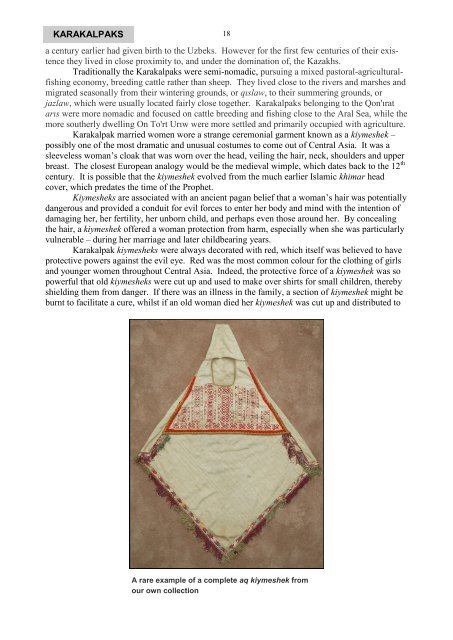Download - OATG. Oxford Asian Textile Group
Download - OATG. Oxford Asian Textile Group
Download - OATG. Oxford Asian Textile Group
Create successful ePaper yourself
Turn your PDF publications into a flip-book with our unique Google optimized e-Paper software.
KARAKALPAKS<br />
18<br />
a century earlier had given birth to the Uzbeks. However for the first few centuries of their existence<br />
they lived in close proximity to, and under the domination of, the Kazakhs.<br />
Traditionally the Karakalpaks were semi-nomadic, pursuing a mixed pastoral-agriculturalfishing<br />
economy, breeding cattle rather than sheep. They lived close to the rivers and marshes and<br />
migrated seasonally from their wintering grounds, or qıslaw, to their summering grounds, or<br />
jazlaw, which were usually located fairly close together. Karakalpaks belonging to the Qon'ırat<br />
arıs were more nomadic and focused on cattle breeding and fishing close to the Aral Sea, while the<br />
more southerly dwelling On To'rt Urıw were more settled and primarily occupied with agriculture.<br />
Karakalpak married women wore a strange ceremonial garment known as a kiymeshek –<br />
possibly one of the most dramatic and unusual costumes to come out of Central Asia. It was a<br />
sleeveless woman‘s cloak that was worn over the head, veiling the hair, neck, shoulders and upper<br />
breast. The closest European analogy would be the medieval wimple, which dates back to the 12 th<br />
century. It is possible that the kiymeshek evolved from the much earlier Islamic khimar head<br />
cover, which predates the time of the Prophet.<br />
Kiymesheks are associated with an ancient pagan belief that a woman‘s hair was potentially<br />
dangerous and provided a conduit for evil forces to enter her body and mind with the intention of<br />
damaging her, her fertility, her unborn child, and perhaps even those around her. By concealing<br />
the hair, a kiymeshek offered a woman protection from harm, especially when she was particularly<br />
vulnerable – during her marriage and later childbearing years.<br />
Karakalpak kiymesheks were always decorated with red, which itself was believed to have<br />
protective powers against the evil eye. Red was the most common colour for the clothing of girls<br />
and younger women throughout Central Asia. Indeed, the protective force of a kiymeshek was so<br />
powerful that old kiymesheks were cut up and used to make over shirts for small children, thereby<br />
shielding them from danger. If there was an illness in the family, a section of kiymeshek might be<br />
burnt to facilitate a cure, whilst if an old woman died her kiymeshek was cut up and distributed to<br />
A rare example of a complete aq kiymeshek from<br />
our own collection
















